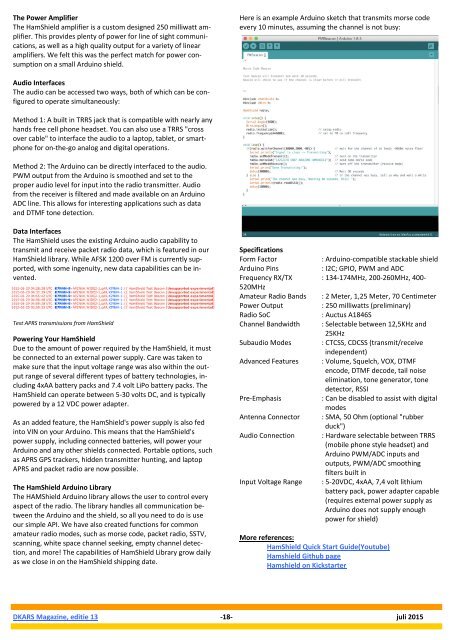DKARS Magazine 201507
DKARS Magazine 201507
DKARS Magazine 201507
You also want an ePaper? Increase the reach of your titles
YUMPU automatically turns print PDFs into web optimized ePapers that Google loves.
The Power Amplifier<br />
The HamShield amplifier is a custom designed 250 milliwatt amplifier.<br />
This provides plenty of power for line of sight communications,<br />
as well as a high quality output for a variety of linear<br />
amplifiers. We felt this was the perfect match for power consumption<br />
on a small Arduino shield.<br />
Here is an example Arduino sketch that transmits morse code<br />
every 10 minutes, assuming the channel is not busy:<br />
Audio Interfaces<br />
The audio can be accessed two ways, both of which can be configured<br />
to operate simultaneously:<br />
Method 1: A built in TRRS jack that is compatible with nearly any<br />
hands free cell phone headset. You can also use a TRRS "cross<br />
over cable" to interface the audio to a laptop, tablet, or smartphone<br />
for on-the-go analog and digital operations.<br />
Method 2: The Arduino can be directly interfaced to the audio.<br />
PWM output from the Arduino is smoothed and set to the<br />
proper audio level for input into the radio transmitter. Audio<br />
from the receiver is filtered and made available on an Arduino<br />
ADC line. This allows for interesting applications such as data<br />
and DTMF tone detection.<br />
Data Interfaces<br />
The HamShield uses the existing Arduino audio capability to<br />
transmit and receive packet radio data, which is featured in our<br />
HamShield library. While AFSK 1200 over FM is currently supported,<br />
with some ingenuity, new data capabilities can be invented.<br />
Test APRS transmissions from HamShield<br />
Powering Your HamShield<br />
Due to the amount of power required by the HamShield, it must<br />
be connected to an external power supply. Care was taken to<br />
make sure that the input voltage range was also within the output<br />
range of several different types of battery technologies, including<br />
4xAA battery packs and 7.4 volt LiPo battery packs. The<br />
HamShield can operate between 5-30 volts DC, and is typically<br />
powered by a 12 VDC power adapter.<br />
As an added feature, the HamShield's power supply is also fed<br />
into VIN on your Arduino. This means that the HamShield's<br />
power supply, including connected batteries, will power your<br />
Arduino and any other shields connected. Portable options, such<br />
as APRS GPS trackers, hidden transmitter hunting, and laptop<br />
APRS and packet radio are now possible.<br />
The HamShield Arduino Library<br />
The HAMShield Arduino library allows the user to control every<br />
aspect of the radio. The library handles all communication between<br />
the Arduino and the shield, so all you need to do is use<br />
our simple API. We have also created functions for common<br />
amateur radio modes, such as morse code, packet radio, SSTV,<br />
scanning, white space channel seeking, empty channel detection,<br />
and more! The capabilities of HamShield Library grow daily<br />
as we close in on the HamShield shipping date.<br />
Specifications<br />
Form Factor<br />
: Arduino-compatible stackable shield<br />
Arduino Pins<br />
: I2C; GPIO, PWM and ADC<br />
Frequency RX/TX : 134-174MHz, 200-260MHz, 400-<br />
520MHz<br />
Amateur Radio Bands : 2 Meter, 1,25 Meter, 70 Centimeter<br />
Power Output<br />
: 250 milliwatts (preliminary)<br />
Radio SoC<br />
: Auctus A1846S<br />
Channel Bandwidth : Selectable between 12,5KHz and<br />
25KHz<br />
Subaudio Modes : CTCSS, CDCSS (transmit/receive<br />
independent)<br />
Advanced Features : Volume, Squelch, VOX, DTMF<br />
encode, DTMF decode, tail noise<br />
elimination, tone generator, tone<br />
detector, RSSI<br />
Pre-Emphasis<br />
: Can be disabled to assist with digital<br />
modes<br />
Antenna Connector : SMA, 50 Ohm (optional "rubber<br />
duck")<br />
Audio Connection : Hardware selectable between TRRS<br />
(mobile phone style headset) and<br />
Arduino PWM/ADC inputs and<br />
outputs, PWM/ADC smoothing<br />
filters built in<br />
Input Voltage Range : 5-20VDC, 4xAA, 7,4 volt lithium<br />
battery pack, power adapter capable<br />
(requires external power supply as<br />
Arduino does not supply enough<br />
power for shield)<br />
More references:<br />
HamShield Quick Start Guide(Youtube)<br />
Hamshield Github page<br />
Hamshield on Kickstarter<br />
<strong>DKARS</strong> <strong>Magazine</strong>, editie 13 -18- juli 2015


